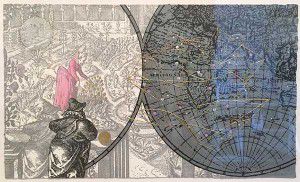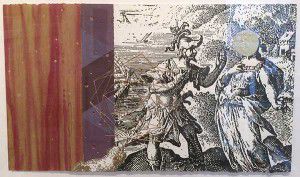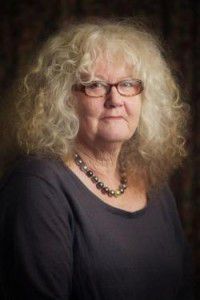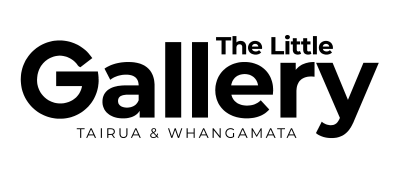Carole Shepheard's Opening Speech
- 11 March 2015
- Sarah Holden
MERCURY BAY ART ESCAPE 2015 OPENING SPEECH
Kia ora and thank you for the opportunity to speak tonight.
Like many of you, where we live is determined by many things – by lifestyle, by opportunity, by accident and sometimes by fate. While more of a pragmatist than a fantasist, I do believe fate had a role to play here. By making the decision to live in the small rural settlement of Kawhia, we, my musician husband and I, chose to leave behind the comfort of both art and music world connections, the safety of understanding well the professional sector and the financial security of well paid jobs. But leaving behind is not an accurate term . . . moving too is much, much better!
I chose to live in a rural environment knowing I would be part of a very different world. Not just the people but stillness, open space and living with the changing seasons. Not only has my day-to-day life changed, I expected this, but so too have my beliefs and values about art and humanity.
 When you are part of a small community you understand the importance of independence and mucking in, the connection to a tangible ever-changing physical environment, the appeal of timelessness (is it really the weekend?), an appreciation of loyal friendships and neighbourhood support structures and the way art intersects and connects with just about everything on a daily basis.
When you are part of a small community you understand the importance of independence and mucking in, the connection to a tangible ever-changing physical environment, the appeal of timelessness (is it really the weekend?), an appreciation of loyal friendships and neighbourhood support structures and the way art intersects and connects with just about everything on a daily basis.
As an artist, resident in my small community of Kawhia, I have become the local designer, printer of T-shirts, designer of posters, muralist, museum director, library and art gallery minder, teacher, judge of school art competitions, environmentalist and eco-warrior, shopkeeper, maker of xmas lights and involved in just about everything where there is a need for things to be done.
While I am told my being here is valued, it is a two-way thing. Giving and receiving. Receiving and giving.
My husband talks of things as either BC (before Carole) or AC (after Carole) and I think of Kawhia in just the same way. I had lived most of my life in inner city Auckland before my professional life, health and head issues and an acute awareness of the need for a drastic change pushed me to this west coast town with a population of under 400. Despite my city friends believing we had gone quite mad (we claimed several bottles of wine from bets that had been placed!), I have no regrets and count each day of the past eight years as a blessing.
Working in a city as a full-time professional artist is hugely difficult unless one has both financial and family support. There are no longer the number of dealer galleries willing to take on new artists, the costs of exhibiting are generally higher, the buying public and audiences, while savvy and cool, are not those who have concern for you after the three week show finishes. If there were more Peter Mcleavey’s and Denis Cohen’s in this world we would be hugely better off! Their hearts knew art and their hearts knew artists.
 Even so, despite media coverage and grand critiques and catalogs, art rewards in big cities are small. Elite artist clusters look after elite gallery clusters who look after the blessed curators, writers, patrons and critics. While new venues appear on a regular basis, they rarely last longer than a year of two. Often they are artist-run, and while they mostly show fresh, raw and challenging work, almost always the artists move on. That’s just the way it is. A good example of how this works is perhaps Simon Denny who will be representing NZ at this years Venice Biennale. He was part of a small art student collective, moved to Berlin and now is internationally recognised.
Even so, despite media coverage and grand critiques and catalogs, art rewards in big cities are small. Elite artist clusters look after elite gallery clusters who look after the blessed curators, writers, patrons and critics. While new venues appear on a regular basis, they rarely last longer than a year of two. Often they are artist-run, and while they mostly show fresh, raw and challenging work, almost always the artists move on. That’s just the way it is. A good example of how this works is perhaps Simon Denny who will be representing NZ at this years Venice Biennale. He was part of a small art student collective, moved to Berlin and now is internationally recognised.
There is however a material world out there that need not be reliant on established city galleries or dealers nor add to increasing personal debt. Ask any artist the costs of making work in large cities and you will be astounded. Pop-up shops, websites, publications, community venues and of course open studios such as MBAE all contribute to a well rounded, dynamic art scene. So too the smaller galleries who have a good understanding or their specific communities, holiday visitors and tourists.
Aotearoa New Zealand may be geographically isolated, and smaller communities even more so but as the ‘New Zealand Edge’ story says, ‘In biology, change – the new stuff – always starts on the fringe of a species, on the edge. This edge metaphor is a perfect fit with our extraordinary history of innovation and our location on the map.’
Brian Sweeney www.nzedge.com
So what can communities like ours do to assist artists and galleries?
We can listen to the needs of artists and we can collectively assist in numerous ways.
On graduation there are major pitfalls for artists. The protective collegial and peer support is gone. The spacious studios, technical workshops and library facilities has gone. Free digital access has gone. And in many cases student collaborations – the heart of big productions, have gone. Most students face the immediate challenge of a financial catch-up (student loan) and often this has to come before learning how to establish their professional careers and what is needed to sustain it.
Research shows that there are four major areas in need of action:
1. Finding studio spaces
2. Finding places to exhibit
3. Acquiring business skills/financial
4. Mentoring
As individuals progress through their careers, other challenges emerge such as the need for access to developmental programs and project funding, opportunities to reach a variety of audiences, professional exchanges and networking, protection of creative rights etc. but another is the possibility now to work from anywhere in the country rather than gravitating towards the bigger centres for some ‘perceived’ career benefit or accolade.
This may well be something that local councils can consider in its future planning – being ‘art friendly’ and drawing individuals to the area where they can creatively thrive.
 This was the rational for Corbans Estate in West Auckland and it is an interesting model that has been able to sustained over decades now. Studios are leased at good rates e.g. for two plus two years; there is a gallery; workshop spaces for teaching as well as Summer and winter schools which draw participants from around the country. There is an excellent sense of communal sharing as well as the ability to be independent and focussed.
This was the rational for Corbans Estate in West Auckland and it is an interesting model that has been able to sustained over decades now. Studios are leased at good rates e.g. for two plus two years; there is a gallery; workshop spaces for teaching as well as Summer and winter schools which draw participants from around the country. There is an excellent sense of communal sharing as well as the ability to be independent and focussed.
The more artists are seen as an independent specialist… the more respect they will get.
Personally I would like to see artists free themselves from the expectations of the marketplace but we are not in the Netherlands where artists are paid a stipend, so the pragmatic in me comes to the fore. There are very few artists in this country who live solely off sales of their work. And alongside this there are many, many artists who gauge their success (and worth) solely by sales of work. This can be so damaging and limiting. When this happens self-doubt and cynicism emerges and the attrition rate is high. Just think the late 80’s financial collapse when many artists – across the visual and performing arts spectrum – gave up. I do not judge these people – family in most cases came first.
While there is no industry standard for what it means to be a “professional” artist there are some important ways in which individuals can increase their chances of progressing their careers to the next level. Questions however of what the ultimate goal is will vary. For some it is gaining recognition through reviews and publications, for others it is popularity for the type of work, for others it is securing a high status city gallery. Hopefully for the majority it is the challenges within art making itself that keeps us involved for all our lives.
On the other side of this perhaps romanticised notion, I hear artists asking for more professional development, financial guidance, one-to-one mentoring, constructive critique, better distribution of information, collaborative/peer opportunities and how to make a successful grant application. All things individuals say would assist and enhance their engagement with the profession. I am a great supporter of the Auckland based organisation Artist’s Alliance, (which I started in 1990) who are well equipped to handle all manner of things related to being a practitioner, and I am also a supporter of Creative Waikato whose catchment area you are in. With the latter, you need to actively communicate your needs and feed them information. They can assist greatly.
Our world is increasingly mediated by visual technologies which are enabling us to see, imagine, understand and act in new ways. The visual arts occupy a special place within contemporary life. Situated between the forms and mechanisms of the mass media and new-imaging technologies in information and communications, defense, medicine and science, they comment on, criticise and eloquently re-state those very conditions which are at the heart of our contemporary experience. McDermott Miller, 1998
As artists in small communities I challenge you to continue to look after your environment and your people. You have the creative means to do this but a lecture on the importance of political art is for another time.
Art is and can be made everywhere, always has been, always will. In downtown offices, in private studios, in abandoned shearing sheds, on small islands, in spare rooms, under gazebos and in collective spaces.
 Why do I love being a Kawhia resident – because the artists are bold, committed, curious, determined, motivated, supportive, resourceful, humble and above all, willing to experiment, take risks, fail and pick themselves up again. And we all believe in this Maori proverb:
Why do I love being a Kawhia resident – because the artists are bold, committed, curious, determined, motivated, supportive, resourceful, humble and above all, willing to experiment, take risks, fail and pick themselves up again. And we all believe in this Maori proverb:
Ihara taku toa I te toa takitahi, he toa takitahi ke
My strength is not mine alone, it comes from the collective.
It’s not about being rich and famous (Andy Warhol has a lot to answer for) but about working equitably alongside the local shop keeper (who keeps storage boxes for you), the local carrier (who delivers your work for you), the unemployed street kid (who you can teach how to become a good graffiti artist), the home gardener (who provides you with excess walnuts) and grey haired somewhat mad artist who drives an open topped Suziki with a palm tree decal on the outside!
This is what community is about for me. This is how it is for me and I imagine how it is for many of you. Thrive in it!
Thank you for your time.
Carole Shepheard March 2015
Enjoyed this article? Sign up to our newsletter below and be the first to hear about our latest Art Chat posts!
